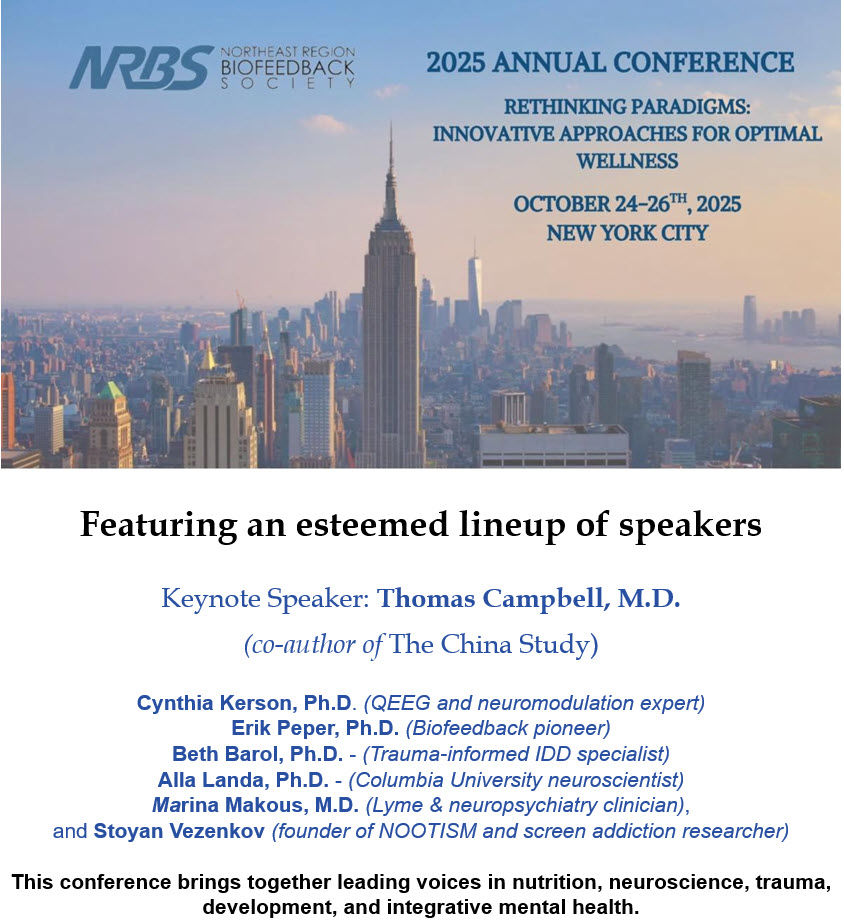The Clinician Detective: Encephalopathy
- BioSource Faculty
- May 20
- 11 min read
Updated: Jun 25

Dr. Ronald Swatzyna, Director and Chief Scientist of the Houston Neuroscience Brain Center, inspired our Clinician Detective series. In his Association for Applied Psychophysiology and Biofeedback (AAPB) Distinguished Scientist address, he reminded his audience that the DSM-5 requires that general medical conditions be systematically ruled out before assigning a psychiatric diagnosis to ensure diagnostic validity and appropriate treatment planning. He argued that in abrupt onset and refractory cases, EEG biomarkers should challenge neurofeedback providers and their medical colleagues to become detectives to identify its causes. This collaborative approach allows each professional to contribute to assessment while "staying in their lane."

Encephalopathy (EN) is characterized by generalized slowing of cortical electrical activity on electroencephalography (EEG).
This global slowing reflects a systemic disturbance in cortico–subcortical integration, where the synchronization between the cerebral cortex and deeper subcortical structures—particularly the thalamus—is disrupted. EN graphic is courtesy of Dr. Swatzyna.

Such disruption is typically the result of metabolic imbalances (such as hepatic or renal dysfunction), toxic exposure (e.g., medications, heavy metals), or hypoxic conditions (oxygen deprivation), which impair neuronal metabolism and ion-channel functioning across broad neural networks rather than causing isolated focal lesions (Swatzyna et al., 2014).
From a neurophysiological perspective, this manifests as a loss of alpha-frequency (8–12 Hz) thalamocortical resonance, which is a normal marker of resting wakefulness. Instead, there is a dominance of lower-frequency rhythms—namely delta (0.5–4 Hz) and theta (4–7 Hz)—which indicate impaired cortical arousal and reduced neuronal synchrony.
This slowing is especially apparent when examining the posterior dominant rhythm (PDR) in occipital leads, which, under normal circumstances, displays reactive alpha activity during eye closure. In encephalopathy, this rhythm often drops below 8 Hz and loses reactivity to external stimuli (e.g., eye opening, photic stimulation, or cognitive tasks), serving as a key diagnostic sign (Brenner, 2021).
For neurofeedback clinicians and functional physicians, this slowing should prompt immediate consideration of systemic contributors. For example, elevated systemic ammonia, uremia, or undiagnosed hypothyroidism can alter brain metabolism and cause these diffuse patterns. These findings should redirect assessment toward laboratory evaluation of hepatic, renal, and endocrine panels before any neurostimulatory protocols are initiated.
Morphological Presentation and Clinical Misinterpretation
Encephalopathy presents with polymorphic delta activity—delta waves that vary in shape and amplitude—over cortical areas, often replacing the normal alpha rhythm. However, the variability in its morphology makes interpretation prone to error, especially by those not trained in clinical neurophysiology.
For instance, in hepatic encephalopathy, practitioners often observe frontal intermittent rhythmic delta activity (FIRDA), which presents as waxing-and-waning delta waves over the frontal regions. This pattern may appear deceptively similar to that seen in certain mood disorders or post-concussive states.
In diffuse axonal injury—commonly due to traumatic brain injury—theta–delta fusion is noted, wherein mixed slow frequencies dominate, often with poor phase synchrony. This can be misattributed to drowsiness or medication effects unless contextualized with history and appropriate filter settings.
A common error in EEG acquisition arises from inappropriate high-pass filtering, which can attenuate slow-wave activity and mask encephalopathic signatures. The International League Against Epilepsy (ILAE) recommends using a low-frequency filter setting of 0.1 Hz and employing bipolar and Laplacian montages. Bipolar montages assess differential voltage between adjacent leads, helping localize rhythms. Laplacian montages, by contrast, subtract the average of surrounding electrodes from a central electrode to highlight local cortical activity, improving spatial resolution of slow-wave abnormalities.
For neurofeedback clinicians employing qEEG-based protocols, it is critical to ensure the preprocessing pipeline honors these standards. Artifact rejection, impedance normalization, and filter integrity are essential in preventing misclassification of pathological slowing as “training targets.” Improperly interpreted slow-wave enhancement protocols risk reinforcing pathological theta or delta rhythms, particularly if training is implemented based solely on regional power metrics without cross-referencing clinical history or metabolic status.
Clinical Implications and Diagnostic Accuracy
Misclassification of encephalopathy in psychiatric settings frequently results in mistreatment, especially when diffuse slowing is dismissed as “non-specific” or attributed to primary psychiatric etiology. The administration of dopamine-blocking agents such as antipsychotics in patients with metabolic encephalopathy can precipitate catatonic states, extrapyramidal symptoms, or neuroleptic malignant syndrome—conditions associated with significant morbidity.
Conversely, incidental findings of age-related alpha slowing in geriatric populations, especially those over 70, can be wrongly attributed to pathology. In these instances, reliance on absolute frequency bands without adjusting for normative age values leads to unnecessary investigations or cognitive decline labeling. This misinterpretation can propagate polypharmacy—especially involving psychostimulants, cholinesterase inhibitors, or mood stabilizers—which in turn increases the risk of adverse drug interactions.
For functional medicine practitioners and neurotherapists, narrative EEG reporting—where physiological findings are contextualized within the clinical presentation—is essential. Instead of isolated spectral metrics (e.g., elevated theta in Fz), findings should be correlated with cognition, alertness, and systemic status. Advanced software platforms allow integration of clinical notes into EEG reports, improving communication between EEG technologists, physicians, and neurofeedback providers.
Behavioral Correlates and Localization of Encephalopathy
While encephalopathy is a diffuse condition, regional amplitude gradients often correspond with specific neurobehavioral symptoms. Frontal-predominant slowing may present with impaired initiation, executive dysfunction, and perseverative behavior—suggesting dysfunction in the anterior cingulate cortex and dorsolateral prefrontal cortex. These findings are often mistaken for depressive or apathic presentations but should instead raise concern for metabolic or vascular compromise.
Posterior slowing, particularly in the parieto-occipital regions, can manifest as impairments in visuospatial awareness and emotional self-processing. Symptoms such as alexithymia or hemispatial neglect may emerge, especially in right-hemisphere dominant posterior slowing. In these cases, qEEG findings typically show excessive theta/delta ratios in P3, P4, O1, or O2 electrodes.
sLORETA (standardized low-resolution brain electromagnetic tomography), a technique that estimates intracerebral current source density, frequently shows hypofunction in the precuneus and midline thalamus—core hubs of the default mode network (DMN). The DMN is involved in self-referential thinking, internal mentation, and autobiographical memory. Dysregulation of these areas, as seen in patients with encephalopathic slowing, often correlates with symptoms of ruminative depression, emotional blunting, and impaired self-awareness (Rios & Sousa, 2020).
Neurofeedback practitioners should consider these spatial signatures when designing protocols. For example, enhancing posterior alpha (via Pz or POz placement) may restore DMN coherence in mild encephalopathic states, while suppressing excessive frontal delta may aid in reestablishing executive function. These interventions should always follow correction of underlying metabolic issues.
State Dependence and Detection Limitations
Encephalopathic slowing is state-dependent, and its detectability can vary based on arousal level. Routine EEG, typically lasting 20–30 minutes, may fail to capture intermittent or mild encephalopathies, especially if the patient is alert and cooperative during testing. However, during sleep, hyperventilation, or post-sleep deprivation, the pathological slowing often becomes more evident.
Extended EEG monitoring—lasting several hours or overnight (ambulatory EEG or inpatient video EEG)—is superior for capturing dynamic fluctuations. qEEG further enhances sensitivity by comparing spectral power and connectivity metrics to age-matched normative databases.
Z-score deviations in posterior dominant frequency or coherence abnormalities between frontal and posterior regions can provide a quantifiable measure of cortical dysregulation.
For older adults, who naturally demonstrate a gradual slowing of alpha frequencies, qEEG systems must employ age-adjusted z-score correction to avoid false positives. Systems such as NeuroGuide and BrainDx offer age-referenced comparisons that help differentiate pathological from age-appropriate slowing.
Illustrative Case Study
Patient History
A 70-year-old male with a history of chronic alcohol use and previously undiagnosed liver disease presented with a 3-month history of progressive cognitive decline, confusion, and memory impairment.
Presenting Symptoms
His family reported increasing episodes of disorientation, visual hallucinations, impaired attention, and marked forgetfulness, significantly affecting daily activities.
Specific Tests and Findings
The initial EEG evaluation revealed generalized polymorphic delta slowing below 6 Hz with amplitudes of 70-100 µV, which was unresponsive to cognitive tasks, consistent with toxic encephalopathy. Blood tests identified significantly elevated ammonia levels, suggesting hepatic encephalopathy due to impaired liver function.
Treatment
Targeted metabolic treatment involved administration of lactulose to reduce ammonia absorption and rifaximin to decrease ammonia production by gut bacteria. Additionally, dietary protein intake was restricted to reduce further ammonia formation.
Detailed EEG and Metabolic Changes
After 4 weeks of treatment, ammonia levels decreased significantly. Follow-up EEG showed normalization of the previously observed slow-wave abnormalities, with restoration of typical alpha frequencies at 9-11 Hz and amplitudes around 30 µV, and improved reactivity to cognitive tasks.
Symptom Resolution
The patient exhibited marked cognitive and psychiatric improvement, with resolution of hallucinations, improved memory, and significantly enhanced orientation and daily functioning.
Flow Chart
Patient presents with cognitive decline, confusion, hallucinations
│
▼
Comprehensive Patient History and Clinical Interview
(Focus on alcohol use, liver disease, and other risks)
│
▼
Initial Diagnostic Assessments:
├─ EEG to detect diffuse slowing (delta waves 70-100 µV, <6 Hz)
└─ Blood tests (especially ammonia levels)
│
▼
EEG and Lab Findings Confirm Hepatic Encephalopathy
(Diffuse slowing and elevated ammonia identified)
│
▼
Initiate Targeted Treatment:
├─ Lactulose (to reduce ammonia absorption)
├─ Rifaximin (to reduce ammonia-producing gut bacteria)
└─ Dietary protein restriction (to minimize ammonia production)
│
▼
Regular Monitoring (every 2-4 weeks):
├─ Repeat EEG to track normalization of alpha waves (9-11 Hz, ~30 µV)
└─ Repeat ammonia levels to confirm metabolic response
│
▼
Clinical Evaluation of Symptom Resolution:
(Assess memory, cognition, hallucinations, orientation)
│
▼
Patient Improvement Confirmed?
├─ Yes ──► Continue Maintenance Treatment & Monitoring
└─ No ───► Re-evaluate diagnosis, treatment compliance,
and consider alternative diagnoses
Clinical Lessons
Neurofeedback providers and functional physicians should glean several critical lessons from this vignette. Foremost is the necessity of incorporating thorough EEG assessments into clinical evaluations to accurately identify underlying cerebral dysfunctions such as encephalopathy.
Providers must remain vigilant in differentiating between EEG patterns associated with metabolic conditions, such as hepatic encephalopathy, and other neurological or psychiatric disorders. This distinction is crucial, as misinterpretation can lead to inappropriate treatments and unnecessary complications.
Additionally, practitioners should recognize the importance of targeted metabolic interventions, including medications such as lactulose and rifaximin, and dietary modifications in addressing specific metabolic imbalances like hyperammonemia.
Regular follow-up through EEG monitoring, accompanied by careful clinical reassessment, is essential to ensure the effectiveness of treatment and resolution of symptoms. Ultimately, this case underscores the value of interdisciplinary collaboration, precise EEG analysis, and tailored metabolic therapies in achieving optimal patient outcomes.
Conclusion
The identification of encephalopathy on EEG is a pivotal component in the differential diagnosis of neuropsychiatric symptoms. For neurofeedback practitioners and functional medicine physicians, recognizing the electrophysiological signature of encephalopathy—especially in the form of global slowing with impaired reactivity—is essential for guiding appropriate metabolic investigations and avoiding iatrogenic harm through misdirected therapy. Advanced tools such as sLORETA, quantitative EEG, and narrative EEG reporting not only enhance diagnostic precision but also enable more targeted, physiology-driven interventions. Encephalopathy is not simply a diagnosis of exclusion; it is a biomarker of global brain dysfunction that, when correctly interpreted, opens the door to reversible and often life-saving treatments.
Key Takeaways
Encephalopathy reflects widespread brain dysfunction often misinterpreted without quantitative EEG.
Structured narrative EEG reports linking morphology to clinical symptoms enhance diagnostic accuracy.
The prevalence of EEG-detected encephalopathy is significantly higher in psychiatric populations than controls.
Correct diagnosis prevents inappropriate medication use and guides effective treatment of underlying conditions.
EEG biomarkers like encephalopathy are critical in moving toward precision medicine in psychiatry.
Glossary
ammonia: a toxic byproduct of protein metabolism, normally detoxified by the liver.
anterior cingulate cortex (ACC): a region of the medial prefrontal cortex involved in emotion regulation, decision-making, error detection, and cognitive control. Dysfunction in the ACC is commonly implicated in mood disorders, apathy, and executive dysfunction.
astrocytes: a type of glial (support) cell in the brain and spinal cord that helps maintain the blood–brain barrier, regulates neurotransmitter levels, and responds to injury. In encephalopathy, ammonia impairs astrocyte function, leading to cerebral edema and disrupted neurotransmission.
BrainDx: an EEG-based software platform designed to provide quantitative EEG (qEEG) assessments. It emphasizes standardized diagnostic EEG interpretation
branched-chain amino acids (BCAAs): essential amino acids (leucine, isoleucine, and valine) that are used in hepatic encephalopathy to bypass hepatic metabolism and support protein balance without exacerbating ammonia production.
cortico-subcortical integration: the functional connectivity and communication between the cerebral cortex and subcortical structures such as the thalamus, basal ganglia, and brainstem. Disruption of this integration contributes to diffuse cognitive and behavioral dysfunction in encephalopathy.
default mode network (DMN): a network of brain regions, including the medial prefrontal cortex, posterior cingulate cortex, precuneus, and lateral parietal cortex, that is active during rest and involved in self-referential thinking, autobiographical memory, and introspection.
delta waves: low-frequency brain waves (0.5-4 Hz) associated with deep sleep and pathological slowing.
dietary management: adjusting nutritional intake to address medical conditions.
dorsolateral prefrontal cortex (DLPFC): a frontal lobe region associated with executive functions such as working memory, planning, inhibition, and cognitive flexibility. Slowing in this area can result in executive dysfunction and attentional deficits.
encephalopathy: a generalized brain dysfunction characterized by altered structure or function due to various etiologies.
FIRDA (frontal intermittent rhythmic delta activity): an EEG pattern consisting of rhythmic delta waves appearing intermittently over frontal leads. Commonly observed in metabolic encephalopathies such as hepatic encephalopathy.
glutamate metabolism: the process by which the excitatory neurotransmitter glutamate is recycled in the brain, primarily through astrocytes. Impaired glutamate metabolism can lead to excitotoxicity and neural dysfunction.
hemispacial neglect: a neurological condition, often resulting from right parietal lobe dysfunction, in which a patient fails to attend to or acknowledge one side of space, usually the left.
hepatic encephalopathy: a neuropsychiatric syndrome resulting from liver dysfunction, particularly in the context of acute or chronic liver failure. It is primarily caused by the accumulation of neurotoxins—most notably ammonia—which are inadequately cleared by the failing liver.
hyperventilation (EEG protocol): a technique used during EEG recordings where the patient breathes rapidly to provoke changes in cerebral physiology. This may help unmask subtle encephalopathic patterns by reducing CO₂ levels, which transiently decreases cerebral perfusion.
ion-channel dysfunction: a disruption in the normal flow of ions (e.g., sodium, potassium, calcium) across neuronal membranes, impairing action potentials and neuronal signaling. Commonly observed in metabolic and toxic encephalopathies.
lactulose: a synthetic sugar used to lower ammonia levels in hepatic encephalopathy.
Laplacian montage: an EEG technique that emphasizes local activity by referencing each electrode to an average of surrounding electrodes.
narrative EEG reporting: a method of EEG interpretation that contextualizes electrophysiological findings with the patient's clinical history, behavioral observations, and systemic status. Enhances communication and clinical accuracy.
NeuroGuide: a quantitative EEG (qEEG) analysis software developed by Applied Neuroscience, Inc. It is used for the assessment of brain function through analysis of digital EEG data.
neuroleptic malignant syndrome: a life-threatening reaction to antipsychotic drugs characterized by fever, muscle rigidity, altered mental status, and autonomic dysfunction. It can be precipitated in encephalopathic patients treated with dopamine antagonists.
neurotransmission: the process of signal transmission between neurons via chemical messengers (neurotransmitters) across synapses. Disruption of this process is a hallmark of encephalopathic conditions.
pathological theta/delta reinforcement: the unintentional upregulation of slow-wave activity (theta or delta frequencies) during neurofeedback training, which can worsen symptoms if those frequencies represent dysfunction rather than trait characteristics.
polymorphic delta: varied forms of delta wave activity indicating diffuse cerebral dysfunction.
posterior dominant rhythm (PDR): the typical alpha rhythm seen in the posterior head regions during wakefulness with eyes closed.
precuneus: a region in the medial parietal lobe that plays a central role in visuospatial imagery, self-awareness, and consciousness. Commonly affected in diffuse encephalopathies and DMN dysfunction.
qEEG (quantitative EEG): a computer-based analysis of EEG signals, which measures spectral power, coherence, and other metrics. It allows comparison against normative databases and supports the identification of subtle deviations from typical neurophysiological patterns.
rifaximin: an antibiotic targeting ammonia-producing bacteria in the intestines.
rumination (ruminative depression): a pattern of persistent, repetitive thinking focused on distressing themes or problems, often observed in depression. Associated with dysregulation in the DMN, particularly the medial prefrontal cortex and precuneus.
sLORETA (standardized low-resolution brain electromagnetic tomography): an EEG source localization technique that estimates the intracranial origin of surface-recorded electrical activity. Used to identify dysfunction within deep brain regions such as the thalamus and precuneus.
thalamocortical resonance: a rhythmic, synchronized interaction between the thalamus and the cerebral cortex, particularly in the alpha frequency range. Disruption of this resonance is a hallmark of encephalopathy.
theta–delta fusion: a combination of theta (4-7 Hz) and delta wave activity often observed after brain injury.
urease-producing bacteria: gut bacteria capable of converting urea into ammonia, contributing to increased systemic ammonia levels in hepatic encephalopathy. Rifaximin targets these organisms to reduce ammonia production.
z-score deviation (in the qEEG): a statistical measure indicating how far a specific EEG feature deviates from the normative mean, adjusted for age and sex. Used in qEEG analysis to identify abnormal brain patterns.
References
Bennett, A., & Husain, A. (2022). Clinical neurophysiology: EEG interpretation. Oxford University Press.
Brenner, R. (2021). Electroencephalography in Clinical Practice. Springer.
Grant, A., Bennett, M., & Husain, A. (2020). Improving EEG interpretation in community neurology practice. Journal of Clinical Neurophysiology, 37(4), 298-306. https://doi.org/10.1097/WNP.0000000000000657
Rios, C., & Sousa, J. (2020). EEG biomarkers in psychiatry. Frontiers in Psychiatry, 11, 1035. https://doi.org/10.3389/fpsyt.2020.01035
Swatzyna, R. J., Tarnow, J. D., Tannous, J. D., Pillai, V., Schieszler, C., & Kozlowski, G. P. (2014). EEG/QEEG technology identifies neurobiomarkers critical to medication selection and treatment in refractory cases. Journal of Psychology & Clinical Psychiatry, 1(7), 00046. https://doi.org/10.15406/jpcpy.2014.01.00046
Swatzyna, R. J., Kozlowski, G. P., & Tarnow, J. D. (2015). Pharmaco-EEG: Individualized medicine in clinical practice. Clinical EEG and Neuroscience, 46(3), 192-196. https://doi.org/10.1177/1550059414556120
Swatzyna, R. J., Morrow, L. M., Collins, D. M., Barr, E. A., Roark, A. J., & Turner, R. P. (2024). Evidentiary significance of routine EEG in refractory cases. Clinical EEG and Neuroscience, 55(2), 100-110. https://doi.org/10.1177/15500594231221313

BioSource Software helped eight Truman State University students attend the 55th Annual Association for Applied Psychophysiology and Biofeedback (AAPB) conference in San Diego.


Support Our Friends









Comments